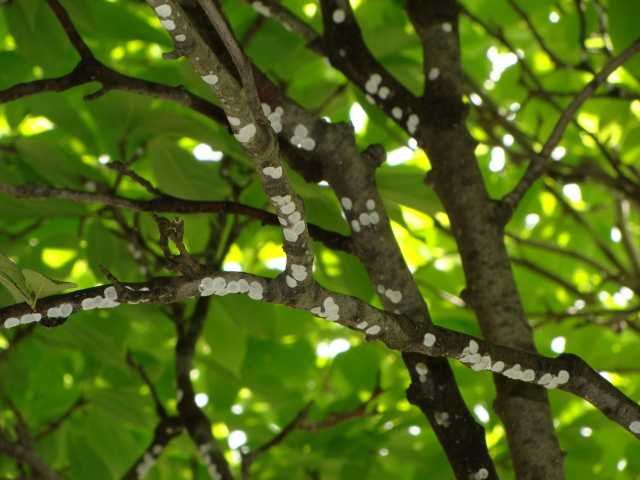Question
 Magnolia tree problem
Magnolia tree problem
Hi,
I hope you could help us with a recent problem on our 20+ yr. old Magnolia tree.
Over the last couple of weeks we have noticed that all of the hostas planted under the tree are shiny with sticky stuff on them. Upon a close inspection of the inside of the tree we've noticed the branches are covered in white
scales and a clear sticky substance is dripping all over from the branches. It's hard to notice this by looking at the outside of the tree because it's such a full tree. When I was standing inside the tree taking pictures I actually felt sticky drops coming down from the branches. This tree is the focal point in our front yard and blooms beautifully every year, we get a lot of compliments on it, so losing this tree would be a disaster for us. We live in the Toronto, Ontario area in a zone 5 growing area. I cannot locate anyone on the internet in our area so I hope you could offer some advice as to what this could be and what we could do to get rid of the problem. Could we lose the tree because of this problem? I will forward pictures.
Thank You
AnswerThese are magnolia scales. Magnolia scales have sucking mouthparts and when heavy infestations completely encrust branches, the branches often die. Badly infested branches and twigs are weakened and growth is retarded. Leaves may also be under-developed. Under a continuous and heavy attack trees may be killed. Like most soft scales, the excess plant sap is excreted as a sweet, sticky material called honeydew. The honeydew drips onto the foliage and branches. A dark fungus, called black sooty mold grows on the honeydew which results in the leaves becoming blackened. This greatly detracts from the plant's normal ornamental value. The honeydew also attracts a ants, bees, wasps and flies which feed on it.
There are insecticidal sprays that will kill the scales but these are diffucult to get the spray to the tree limbs when the tree is large. I would recommned a soil applied insecticide.
Imidacloprid (Bayer Advanced Garden Tree & Shrub Insect Control Concentrate) is applied as a drench around the root zone of infested plants. This water soluble insecticide is taken up by the roots and transported throughout the plant where it is ingested by sap feeding insects. This provides a means of scale control without reliance on sprays.
The success or failure of control efforts may not be readily apparent but here are some things to check.
Dead soft scales often fall off of the plant. Live scales should produce a liquid when mashed, dead scales will be dry and not "bleed" when crushed.
New foliage of infested plants should have a healthier appearance once the scale burden has been removed. Buds should break a little earlier than when the plant was infested and expanded leaves should have normal color and turgor.
Sooty mold and shiny leaves should gradually disappear from plants that were infested with soft scales.
Here is a web link to the Bayer product. Check with your local nursery for this product. http://www.bayeradvanced.com/product/Tree-Shrub-Insect-Control/concentrate.html






